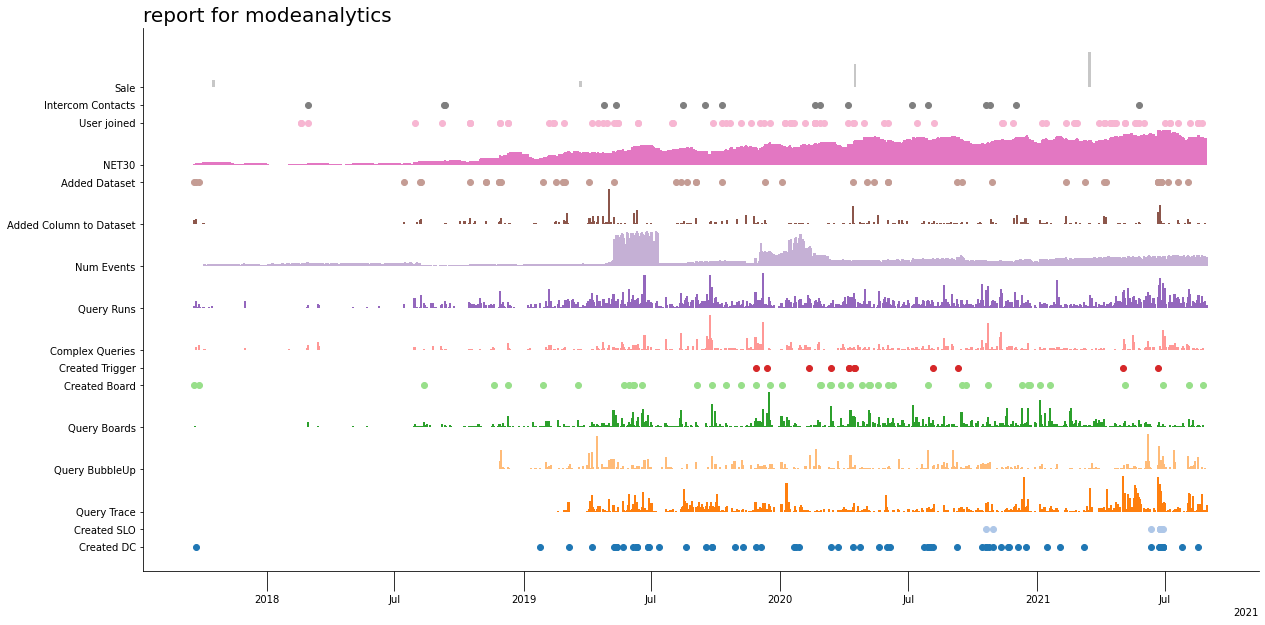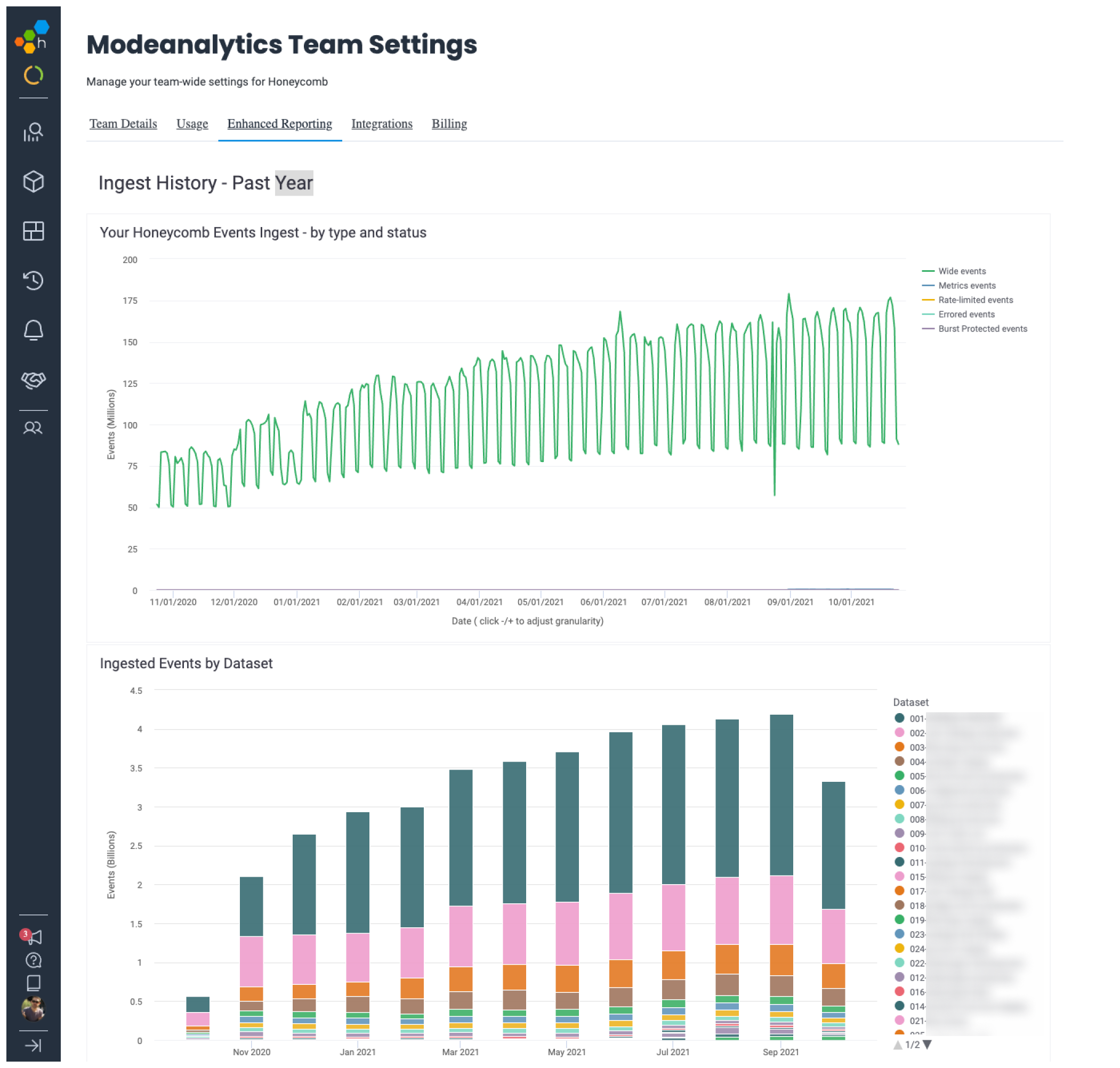
CASE STUDY
Honeycomb gets stickier with Mode
Honeycomb builds observability software to help engineering teams eliminate toil and delight their users.
Data Stack

Snowflake

Fivetran

dbt

Census

Mode
We’re asking questions we couldn’t ask before.


Challenge
Disconnected data and manual workflows
“We were drowning in a sea of data.” Irving Popovetsky, the Director of Customer Engineering at Honeycomb.io, was dealing with a lot of data in a lot of places—Salesforce, Stripe, Intercom, Hubspot, Amplitude, to name a few. And for a while, he and his colleagues at Honeycomb were making it work manually: switching between tools, querying product data using Metabase, and stitching data from other sources together in CSV extracts.
Then came a big data-intensive project: changing the entire Honeycomb pricing model. In order to offer transparent and predictable pricing to customers, Honeycomb decided to switch from a traditional seat-based model to a usage-based pricing model.
The old approaches could not meet the challenges presented by the project. Disjointed data and a lack of interactivity hamstrung the critical project of moving customers onto the new pricing model. Repeatedly delayed and frustrated by blockers in their data stack, the Honeycomb team vowed “never again.”
In order to make decisions fast and keep pace with the company’s growth, Popovetsky understood that Honeycomb had to build a modern data stack.
Solution
A modern data stack with Mode as the front-end
After successfully moving all customers onto the new pricing model, Popovetsky and his team set about rebuilding their entire data stack. Snowflake was the choice for their new cloud data warehouse, and the team selected Fivetran as their data integration provider.
For the front-end of the stack, the team needed an analytics tool that would be fast, flexible, and extensible. They chose Mode to be the platform where Honeycomb’s data and Honeycomb’s people would come together to drive decision-making.
With the goal of placing customers at the center of that decision-making, the team’s Principle Design Researcher, Danyel Fisher, wanted to answer key questions about their usage of the product. One of his questions was: are users actually taking advantage of Honeycomb’s capabilities and getting the most out of their subscription?
Fisher used Mode to explore the relevant data sources and share his insights, which allowed him to iteratively get feedback from the customer success team on what would be most valuable. He also took advantage of Mode’s Notebook environment to slice data and build visualizations using Python. For Fisher, querying and joining data in SQL then exploring and visualizing in Python proved to be the ideal workflow for answering the question and building a data application for the entire customer success team to use.
The resulting Customer Timeline app, which runs out of Mode Report, pulls data from multiple sources to tell a complete, coherent story about a customer’s progress with Honeycomb over time.

Honeycomb Customer Timeline App running in the Mode Notebook
As Mode usage grew and Honeycomb’s customer success team began to reap the benefits of data-driven decision-making, they thought about another group that would also enjoy those benefits: their customers.
“At the core of it, we’re a data company,” Popovetsky said. “Our customers are our customers because they love data. Our Honeycomb usage page, the page where you’d go to understand what value you’re getting from the product, communicated only 1% of what we wanted to communicate.”
Mode’s White Label Embeds, a feature that embeds Mode visualizations into other products and platforms, enabled Popovetsky’s team to surface usage insights to customers without placing undue burden on Honeycomb’s engineers.

Honeycomb Usage Reporting powered by Mode White Label Embeds
“
White Label Embeds allowed us to take what we were already learning in customer success and give it straight to customers within a couple of hours.
Irving Popovetsky Director of Customer Engineering
Impact
Better conversations, faster iteration, more value delivered to customers
Today, Honeycomb’s sales and customer success teams have richer, better-timed conversations with customers and prospects.
“The quality of data around customer health and around when to go interact with customers is night and day; it’s a qualitatively different experience,”Fisher said. “We’re asking questions that we couldn’t ask before.”
Honeycomb’s customers are enjoying the benefits of these conversations in addition to the benefits of insights delivered directly to them via Mode’s White Label Embeds.
For both internal and external use cases, speed to insight and ease of iteration have strengthened the connection between data and customer value.
“We can now iterate very very quickly,” Popovetsky said. “If a customer says, ‘Hey, I wish you could show me this,’ one of my people can put that together and we can get it added to the report in no time at all. We can improve, expand, and correct in a much faster way and give that value directly back to customers.”
“
We wanted to show our customers so much more about where they’re getting value out of their product, and we do that now.
Irving Popovetsky Director of Customer Engineering


